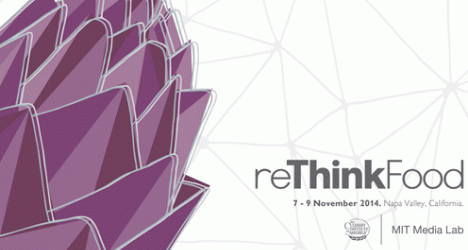reTHINK FOOD 2014 – Napa Valley California : C’est dans cette magnifique région de la côte ouest américaine que se sont donnés rendez-vous plus de 350 leaders et les innovateurs des sciences, des technologies, du design, tous préoccupés par l’amalgame des comportements humains, de la culture et de la nourriture. C’était l’occasion de se pencher sur les stratégies qui influencent les choix des consommateurs et mieux comprendre les tendances qui dictent et dicteront la commande en matière d’alimentation. Voici un bref communiqué paru au lendemain de cet événement qui s’est déroulé sur trois jours – Edikom y était pour vous en la présence de notre présidente, Lyne Gosselin. Toute une section de notre magazine l’actualité ALIMENTAIRE spécial Tendances et innovations y sera consacrée, disponible en janvier 2015!
St. Helena, CA, November 10, 2014 — More than 350 executives, thought leaders, and innovators in technology, behavior, design, and food gathered this past weekend at The Culinary Institute of America at Greystone in the Napa Valley for the first edition of reThink Food. This groundbreaking conference, co-presented by the CIA and the MIT Media Lab, showcased insights into the future of food and the integration of technology in that future, and imagined a new revolution in food and foodservice.
“We are at a pivotal moment when culinary, technology, and behavioral experts must collaborate to address the challenges we all see for our future,” said CIA President Tim Ryan. “This convergence can create a business landscape in which higher quality, more engaging food experiences evolve through innovations in technology and design, and move us on to the next big idea—producing value-based strategies that connect our industry to the needs and expectations of today’s consumers. This weekend, reThink Food became such a place of convergence.”
Ryan shared the stage with Media Lab Director Joi Ito, who spoke about the way food brings together so many different, seemingly disparate areas—art, science, and design—much the way the MIT Media Lab does. « At the Lab we routinely break down entrenched silos, and see a need to do the same for the food sector, » said Ito. « Today’s consumers not only want to know more about what they’re eating, but also how it’s produced, transported, and packaged. Going forward, everyone from growers, to food technologists, to chefs, will be taking on new, interconnected roles in reshaping how we think about, prepare, and consume our food. »
Keynote speaker Tom Standage, journalist at The Economist and author of books that track the culture of food (An Edible History of Humanity) and the rise of technology (Writing on the Wall), opened the conference with an illuminating review of the key historical milestones in food and technology that brought us to where we are today. Other presenters, including Will Rosenzweig of Physic Ventures, Pulitzer Prize winner Michael Moss, and Google’s Michiel Bakker, discussed technology’s evolving role in food innovation as well as the consumer’s changing response to technology when it comes to eating and cooking.
Breakthroughs in neuroscience also reveal what role our brain plays in food choices. Scientists Lisa Mosconi of NYU School of Medicine, Ki Goosens of MIT’s McGovern Institute, and Daphne Miller from UC San Francisco reviewed how a better understanding of the relationship between body and environment could inform innovation in product development and healthier eating habits. Other discussion topics included how technology might change how we shop for food, our food supply in local and global perspectives, and how the design of our food environments affects what we eat.
Throughout the three days, eyes and ears were on the future—what will our culinary future look like and who will shape it across the next five, 10, or 20 years? What we consume, how we procure it, and the relationship between man and machine in that process are at the center of large-scale changes that we don’t fully understand. The CIA and the MIT Media Lab, through reThink Food, gathered a community committed to uncovering these changes so we can responsibly prepare for the future.
Additional information, including video from a live webcast of the conference, can be found on the website, www.re-thinkfood.org.

